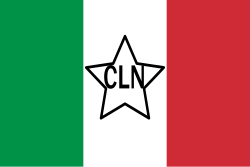You can help expand this article with text translated from the corresponding article in Italian. (October 2017)Click [show] for important translation instructions.
|
Republic of Alba Repubblica di Alba | |||||||||
|---|---|---|---|---|---|---|---|---|---|
| 1944 | |||||||||
Flag | |||||||||
| Status | Unrecognized state | ||||||||
| Capital | Alba | ||||||||
| Common languages | Italian | ||||||||
| Government | Partisan republic | ||||||||
| Historical era | World War II | ||||||||
• Established | 10 October 1944 | ||||||||
• Conquered | 2 November 1944 | ||||||||
| Currency | Italian lira | ||||||||
| |||||||||
The Republic of Alba was a short-lived state that existed from 10 October to 2 November 1944 in Alba, northern Italy, as a local resistance against Italian fascism during World War II, and which was part of the so-called Italian Partisan Republics, the first of which was the Republic of Corniolo. It was named after the Napoleonic Republic of Alba that existed in 1796 in Piedmont.

